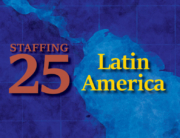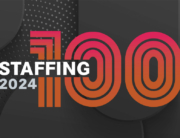Although 36% of employers plan to add full-time staff and 46% plan to hire temps and contractors this year, staffing industry recruiters will need superior skills and substantial experience to ring the register.
Growing talent shortages, expanding skill gaps, rising client expectations and the proliferation of passive candidates are just a few of the new-age trends that savvy executives hope to counter by increasing the knowledge and tenure of their internal recruiting teams.
“Experienced recruiters aren’t interested in switching jobs when times are good, because they’re making too much money,” says Louis Song, CEO and co-founder of PROVEN. “Poaching isn’t a viable option, growing our own talent is the next logical step in our development.”
“Most staffing firms hire 80 people and end up with 20,” said Ingram Losner, PROVEN’s co-founder and CFO. “But that strategy is neither sustainable nor scalable. We’re aiming for 100% retention of our top performers and the development of new leaders who can take on more responsibility.”
Continuous learning is what allows an organization to stay competitive in an ever-changing environment. Studies show a strong learning culture improves staff engagement and retention, enriches the customer and candidate experience, fosters sustainable growth and ultimately boosts business performance. Indeed, innovative companies like Boeing, IBM, Google and Apple are just a few of the juggernauts that attribute their long-term success to a strong learning culture.
But transitioning into a learning organization frequently requires a new approach and structural changes because the thirst for knowledge and the ability to grow people must be systemically woven into an organization’s DNA and infrastructure.
Here’s how several fast-growing firms plan to create a sustainable competitive advantage by morphing into full-fledged learning organizations.
Build a Learning Ecosystem
While many staffing firms provide new-hire training, it’s only one element in a vibrant ecosystem where people, resources and knowledge interact with each other in ways that foster continuous learning, knowledge sharing and the evolution of sustainable, repeatable processes.
For instance, PROVEN’s co-founders tied employee compensation to professional growth, creating a vital interactive link in their nascent ecosystem.
“This year, we gave our employees development goals in addition to financial targets because the two are inter- twined,” Song explains.
“And to make sure we’re all rowing in the same direction, a portion of our leaders’ bonuses are tied to the training and development of their people,” Losner adds.
Song and Losner initially assessed their staff ’s strengths and weaknesses in fundamental areas such as recruiting, account management and sales. Developing a baseline not only helped the co-founders spot knowledge gaps, it inspired the launch of PROVEN University.
PROVEN’s recruiters receive 22 hours of online training along with weekly instruction from in-house subject-matter experts on candidate marketing, client visits and techniques for screening and selecting specialized tech professionals such as data analysts or project managers. Since accountability is another critical ecosystem component, employees must affirm the assimilation of their newfound knowledge by passing a daily quiz.
When phone records showed a decline in talk time, Sheldon Wolitski worried his recruiters lacked the relationship building and communication skills to thrive in a LinkedIn world where some 85% of employees think of them- selves as passive candidates. The CEO and founder of The Select Group (TSG) not only added 40 hours of intense role plays and a certification process to his training program, he accelerated change by modifying his business practices.
Formerly, only TSG’s account managers met with clients. Now, recruiters tag along so they can gain an in-depth understanding of the technical requirements and environment and convert assignment details into compel- ling pitches.
“The days of reading a job description to garner a candidate’s interest are over,” Wolitski notes. “Candidates are bombarded with information and opportunities. Unless you leave a detailed, personal message, they’ll just delete it. We don’t even attempt to talk to a candidate until we’ve discussed the requirements with the client.”
After years of haggling over hourly rates, clients are finally willing to pay a premium for IT contractors Wolitski added. But only when a candidate matches the job description and culture to a tee.
“The IT skills gap is real and growing so recruiters can’t rely on sourcing, they need the ability to develop contractors,” he said. “Moreover, LinkedIn has changed recruiting into networking. Our team needs the ability to ask for referrals without making the candidate feel like they’re being taken advantage of. ”
Multi-Agent Approach
Executives of learning organizations actively support and encourage ongoing information exchanges among co-workers, clients and outside experts. After all, knowledge exists everywhere — not just in the classroom — and staffing industry professionals need facts and data to satisfy the needs and expectations of clients and candidates.
For example, MetLife and Citrix plan to hire 1,000 people in the Raleigh area but attracting a large number of IT professionals hasn’t been easy, even though both companies boast marquee employment brands.
“They’re turning to us for salary data, market intelligence and strategies for attacking the market,” Wolitski says.
To rev up his team’s intellectual horsepower Wolitski invests in networking licenses on LinkedIn, external sources of salary and labor market data and he even purchased a new ATS with enhanced capabilities. He also fosters collaborative information exchanges with clients that often beget the development of a shared recruiting strategy.
“I believe in complete transparency,” he says. “We invite hiring managers into our office so they can see our recruiting systems, review our data and even see how we incentivize our employees.”
Meanwhile, Mark Eldridge has appointed a dedicated communications representative so his team is up to snuff on legislative changes that mandate paid sick time, healthcare and minimum wage increases for contingent workers.
The CEO and founder of ALKU Technologies also formalized his approach to leadership development by focusing on knowledge transfer.
Each week, two members of ALKU’s leadership team share best practices on a variety of pertinent management topics. For instance, the group recently held a round table discussion and came up with a number of ways to ensure consistent interviewing practices and increase accountability.
Eldridge attributes his fervor for knowledge management to his educational roots. He has a bachelor’s degree in English.
“Capturing, developing, sharing and effectively using organizational knowledge is the key to success in an increasingly complex industry,” Eldridge says. “We dedicate a lot of time and energy to knowledge transfer.”
Feeder System
Staff shortages and depleted bench depth can hinder expansion and impact the bottom line. However, Eldridge has managed to avoid bidding wars for experienced players and non-compete entanglements while increasing his staff 25% by creating a farm team or feeder system.
ALKU’s interns get a taste of the staffing industry over the course of 18 to 20 weeks. The college student indoctrination program has been instrumental in creating a robust pipeline of junior recruiters, who’ve proven that they take the heat and hit the ground running. Last summer, for instance, 11 of the firm’s 19 interns accepted full-time offers. This year, Eldridge expects a good portion of the firm’s 30 to 35 new hires to come from the intern pool.
The internship program also helps Eldridge identify emerging leaders as experienced staffers get a chance to cut their managerial teeth by training and mentoring one or two student-recruiters. The successful auditions have boosted bench depth through the promotion of eight new leaders.
“To me, continuing to find and train internal staff is our biggest challenge,” Eldridge says. “Our internship program has been instrumental in helping us develop a self-replicating mechanism.”
Become a Learning Leader
Although there’s ample empirical evidence to validate the connection between learning and business performance, staffing executives need benchmarking and data to validate their investments in training and development.
Fortunately, we don’t have to look far to find a bona fide success story. Veronica Edwards attributes InGenesis’ meteoric rise to recent investments in technology and the development of internal staff who hail from outside the industry.
The CEO says her educational efforts not only helped her team prepare for the Joint Commissions’ Health Care Staffing Services Certification and the Malcolm Baldrige National Quality Award, they were instrumental in fueling the firm’s organic growth.
“Our staff is a melting pot,” she says. “We’ve hired 100 people from outside the industry and trained them on our recruiting processes which helped us grow over 100% last year.”
“We expect the same activity but greater success as the tenure and capabilities of our staff increase,” ALKU’s Eldridge explains. “For instance, we expect a sales person to make new contacts and bring in more orders and a recruiter to make more submittals and placements.”
Wolitski uses an executive dashboard to track his team’s progress. Initially, he’s looking for an increase in the amount of time they spend conversing with clients and candidates followed by a rise in submittals from 10 each week to 11 or 12 and an improved fill ratio.
“An increase in talk time is a sign that our training and structural changes are working,” he says. “I’ll also monitor our net promoter score and spread per producer to see how we’re doing.”
If things go as planned, the improvement in activity will produce a forecasted 2.5% growth in TSG’s EBITDA in 2015.
Eldridge summed it up: “The attainment of every one of our financial goals relies on the performance of the people who sit at our desks. That’s why we’ve made the hiring and development of internal staff our top priority in 2015.”







